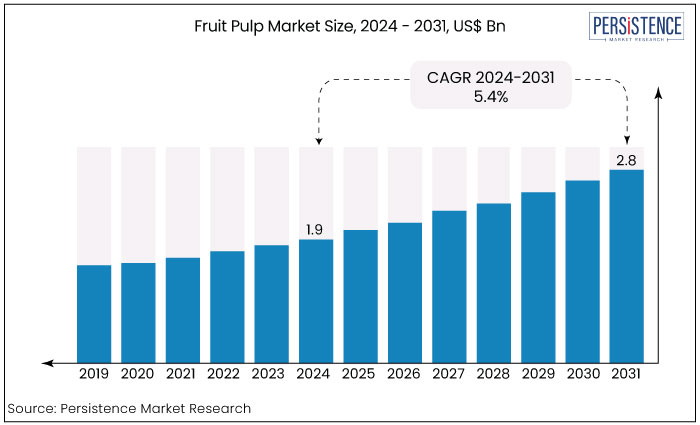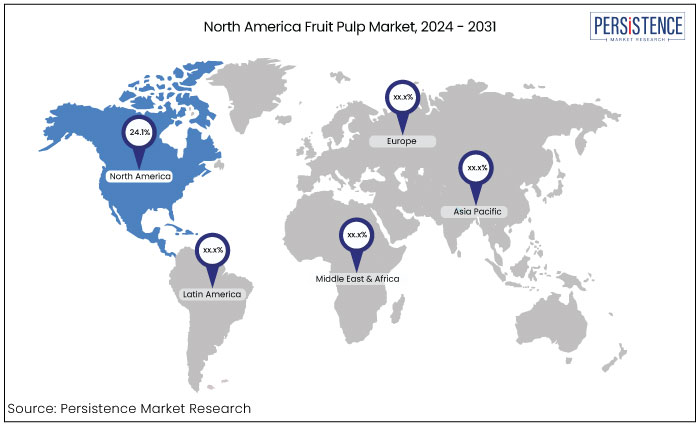Industry: Food and Beverages
Published Date: October-2024
Format: PPT*, PDF, EXCEL
Delivery Timelines: Contact Sales
Number of Pages: 166
Report ID: PMRREP20215
The fruit pulp market is estimated to increase from US$1.9 Bn in 2024 to US$2.8 Bn by 2031. The market is projected to record a CAGR of 5.4% during the forecast period from 2024 to 2031. The escalating consumer demand for organic food products is a primary driver of growth in the global market. As health-conscious consumers increasingly seek natural and organic options, the popularity of fruit pulp continues to rise, catering to this trend.

Key Highlights of the Market
|
Market Attributes |
Key Insights |
|
Fruit Pulp Market Size (2024E) |
US$1.9 Bn |
|
Projected Market Value (2031F) |
US$2.8 Bn |
|
Global Market Growth Rate (CAGR 2024 to 2031) |
5.4% |
|
Historical Market Growth Rate (CAGR 2019 to 2023) |
5.0% |
|
Region |
Market Share by 2031 |
|
North America |
24.1% |
North America is expected to capture 24.1% of the market share by 2031. This growth is largely driven by a rising number of consumers in the region who are increasingly choosing healthy food alternatives including minimally processed and natural ingredients. The nutritional benefits of fruit pulp resonate strongly with these evolving consumer preferences.
The growing inclination toward vegan and plant-based diets is opening up significant opportunities for businesses in the fruit pulp sector. As more individuals seek nutritious and natural products, market players are well-positioned to capitalize on this trend, further solidifying North America’s influential role in the global fruit pulp landscape.

Asia Pacific region is anticipated to experience the most rapid growth in the fruit pulp market during the forecast period, primarily due to a heightened awareness and demand for fruit pulp products among consumers. This increasing recognition of the health benefits associated with fruit pulp is driving market expansion.
The region's favorable tropical climate creates ideal conditions for the cultivation of a wide variety of fruits leading to the establishment of extensive plantations. This agricultural abundance significantly mitigates the risk of raw material shortages during the manufacturing process ensuring a steady supply chain. As a result, Asia Pacific is well-positioned to capitalize on the growing trend toward natural and nutritious food options.
|
Category |
Market Share in 2023 |
|
Application - Food |
47.2% |
The food segment accounted for the significant market share of 47.2% in 2023. Demand for the segment is due to the increasing trend of opting for natural fruit and vegetable pulp in the food applications including fillings, baking, beverages and jams. Manufacturers engaged in the vegetable and fruit pulp production are continuously trying to enhance product properties to fulfill changing demands of consumers.
The market is distinctly categorized by its applications into two primary sectors: Foods and Beverages. In 2024, the beverages sector is expected to dominate the market share and is expected to maintain its leadership throughout the forecast period from 2024 to 2031.
This upward trend is largely driven by a growing consumer shift away from artificially flavored carbonated drinks towards healthier, natural options like fruit pulp beverages, a response to rising global rates of lifestyle diseases and obesity.
The fruit pulp market overview shows that the industry is growing rapidly and is expected to reach a healthy market size in the upcoming years. The industry refers to the industry segment that produces and sells processed fruit pulp, which is derived from various fruits through methods such as crushing, blending, and straining. This pulp acts as a versatile ingredient in a wide array of food and beverage applications, including smoothies, jams, sauces, desserts, and even alcoholic beverages.
The sector is experiencing significant growth, driven by rising consumer awareness regarding healthy eating and the increasing demand for natural ingredients in food products. A notable trend is the shift towards organic and sustainably sourced fruit pulps, as consumers become more discerning about the origins of their food and its environmental impact. This trend is bolstered by a growing preference for clean-label products, which are perceived as healthier and more transparent.
The expansion of the beverage industry particularly in smoothies and ready-to-drink products, is one of the influencing market trends. It is propelling the demand for fruit pulp as manufacturers seek to create convenient and nutritious options.
Innovations in processing technology are also contributing to market growth by enhancing the shelf life and quality of fruit pulp making it an attractive option for producers. Additionally, the rise of e-commerce and online grocery shopping is facilitating wide access to diverse fruit pulp products further driving market expansion.
The fruit pulp market analysis has shown notable growth over the past decade driven by increasing consumer demand for natural and healthy food options. Historically, the market expanded significantly from 2019 to 2023 as health trends shifted toward consuming whole foods and natural ingredients. This growth was further fueled by the rise of the smoothie and beverage industry, where fruit pulp became a key ingredient due to its flavor and nutritional benefits.
The market's expansion was also supported by innovations in processing technologies that improved the quality and shelf life of fruit pulp making it appealing to manufacturers and consumers alike.
The industry is poised for continued growth. The increasing focus on health and wellness among consumers is expected to drive demand for fruit-based products particularly in the beverage and snack sectors. Additionally, the trend toward organic and sustainably sourced ingredients will likely to shape the market creating several opportunities for food choices.
The ongoing development of e-commerce platforms will also enhance accessibility to a broad range of fruit pulp products further stimulating market growth. As manufacturers innovate and adapt to these trends, the market is set to thrive aligning with the broad movement toward healthy, and sustainable food options.
Rising Health Consciousness
The increasing awareness of health and wellness among consumers is a significant driver for the market growth. As people become informed about the benefits of natural ingredients, they are actively seeking products that offer nutritional value without artificial additives.
Fruit pulp rich in vitamins, minerals, and antioxidants aligns perfectly with this trend. This shift toward healthy eating habits has led to a surge in demand for fruit-based products including smoothies, snacks, and desserts thereby propelling the fruit pulp market growth.
Expansion of the Beverage Industry
The beverage industry has seen remarkable growth particularly in segments like smoothies and functional drinks, which heavily utilize fruit pulp as a key ingredient. This trend is driven by consumer preferences for convenient, nutritious, and flavorful options.
Manufacturers are increasingly incorporating fruit pulp into their products to enhance taste and nutritional profiles, catering to the demand for healthier beverages. As the market for ready-to-drink products continues to expand, the demand for fruit pulp is expected to benefit significantly from this ongoing trend.
Innovation in Processing Technologies
Advancements in processing technologies have played a crucial role in the growth of the fruit pulp market revenue. Improved methods for extracting and preserving fruit pulp have enhanced its quality, flavor, and shelf life, making it more appealing to manufacturers and consumers alike.
These innovations allow for better retention of nutrients and flavors, which is essential for maintaining the integrity of fruit-based products. As processing techniques continue to evolve, they will further support the expansion of the market by enabling the production of higher-quality, value-added products.
Supply Chain Challenges
The market faces significant challenges related to supply chain logistics particularly in sourcing fresh fruits. Factors such as seasonal availability, transportation issues, and postharvest handling can lead to fluctuations in supply, impacting production consistency.
Fresh fruits are susceptible to bruising and spoilage during harvesting and transportation, which can reduce the quality and quantity of pulp available for processing. These supply chain disruptions can result in increased costs and limited product availability ultimately hindering the market growth.
Competition from Alternatives
The growing competition from alternative ingredients, such as artificial flavorings and other fruit substitutes, also impedes the fruit pulp market expansion. As manufacturers seek to reduce costs and improve profit margins, they may opt for cheaper, synthetic alternatives that mimic fruit pulp's taste and texture without the associated health benefits.
This trend poses a challenge for the market as consumers may be swayed by lower-priced products that lack the nutritional value of natural fruit pulp thereby limiting market growth opportunities.
Expansion in Health and Wellness Products
The growing trend towards health and wellness presents a significant opportunity for the fruit pulp market. As consumers increasingly seek out clean-label, nutrient-dense products, manufacturers can leverage fruit pulp to create innovative offerings in health-focused segments such as functional snacks, protein bars, and dietary supplements.
By emphasizing the natural, wholesome qualities of fruit pulp, brands can appeal to health-conscious consumers looking for convenient ways to incorporate fruits into their diets. This alignment with wellness trends can drive product development and open new revenue streams for the market.
Rising Demand for Plant-Based Foods
The global shift toward plant-based diets offers a promising opportunity for the market. As consumers adopt vegan and vegetarian lifestyles, the demand for natural ingredients that can enhance the flavor and nutrition of plant-based products is on the rise.
Fruit pulp can be utilized in a variety of applications, from dairy alternatives to desserts and baked goods, providing a natural sweetness and texture. By capitalizing on this trend, manufacturers can innovate and expand their product lines, tapping into the growing segment of plant-based consumers seeking healthier options.
The fruit pulp market is characterized by intense competition among key players striving to innovate and capture consumer interest. For instance, The Coca-Cola Company has launched several innovative products since 2022, including fruit pulp-infused beverages aimed at health-conscious consumers. Their focus on reducing added sugars while enhancing flavor profiles demonstrates a commitment to meeting evolving consumer preferences.
Nestlé has introduced new fruit pulp-based snacks that cater to the growing demand for nutritious, on-the-go options. These innovations reflect a broader trend in the market towards healthier, more natural ingredients, positioning these companies favorably for future growth.
Recent Developments in the Fruit Pulp Market
|
Attributes |
Details |
|
Forecast Period |
2024 to 2031 |
|
Historical Data Available for |
2019 to 2023 |
|
Market Analysis |
US$ Billion for Value |
|
Key Regions Covered |
|
|
Key Market Segments Covered |
|
|
Key Companies Profiled |
|
|
Report Coverage |
|
|
Customization & Pricing |
Available upon request |
By Fruit Type
By Distribution
By Application
By Region
To know more about delivery timeline for this report Contact Sales

The market is predicted to rise from US$1.9 Bn in 2024 to US$2.8 Bn by 2031.
Some of the leading industry players in the market are Iprona AG, Agrana Group, and Paradise Juice Private Limited.
The market is projected to record a CAGR of 5.4% through 2031.
North America is a leading regional market for fruit pulp.
A shift toward organic and sustainably sourced fruit pulps presents a key opportunity for the market players.